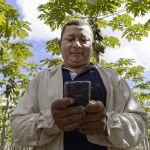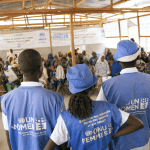Financial Services for Real People: Using Behavioral Science to Boost Financial Health in Latin America
Managing day-to-day finances and planning for the future are quite complex. We rely on products and services to keep us on track with these tasks, yet many tools fail to account for common human tendencies, such as prioritizing the present over the future and putting off tedious tasks. These tendencies, although universal and understandable, have serious ramifications for the financial health of people everywhere.
That’s why ideas42, a nonprofit behavioral design lab, and MetLife Foundation created a partnership to innovate financial services based on the latest research from the science of human behavior. Over the past two years, we have examined the behavioral barriers standing in the way of financial health for low-income people in two pilot markets, Mexico and Chile, and designed solutions that facilitate retirement savings, short-term savings and access to credit.
Right now, we’re rigorously testing our solutions and analyzing the results so we can share insights across these countries and beyond. We believe our findings will help more providers deliver products that make it simpler to manage cash flows and debts, helping more people to protect themselves and their families through savings and to pursue new opportunities through credit.
Keeping paths to credit open
Access to credit is a critical resource for borrowers and can produce significant benefits — from job retention to higher incomes. Yet according to a national survey in 2015, 35 percent of Mexicans reported the rejection of a loan application due to low credit scores. Nearly 30 percent of people scored 660 or below, the cut-off point at which a borrower is seen as a medium to high risk of non-repayment.
A major factor in low credit scores is late loan payments. So in our effort to keep paths to credit open, we spoke with clients of kubo.financiero, the first regulated peer-to-peer online lending platform in Mexico, to learn what gets in the way of on-time payments. One barrier we found is simply that few people had actually thought through how they would pay back their loan. Many had financial goals but no clear plan, making those goals much less likely to be achieved. Another obstacle is borrowers’ tendency to focus on short- rather than long-term consequences. Although most people were aware of the immediate costs of missing a payment (e.g., late fees), almost no one we interviewed mentioned the damage to their credit score or the greater likelihood that they might be denied a loan—or pay higher interest for it—in the future. When both the plan for repaying and the consequences of failing to do so remain vague in people’s minds, the likelihood of loan delinquency increases significantly.
We are developing tailored solutions to address these issues. We will provide timely reminders to make the long-term consequences of late payments clearer to the borrower. We will also send feedback, either congratulating them for paying on time or notifying them that they incurred a fee, and help clients create a plan for paying on time moving forward. The plans will include elements of positive motivation, encouraging clients to set themselves on the path towards the better, lower-cost loans that a better credit score makes possible.
Redesigning retirement savings
In Mexico, 27 percent of the elderly population lives in poverty. Although the country has a national pension system for its citizens, it only applies to those with formal employment (about 40 percent of the population). And the average worker making the mandatory contribution can, optimistically, expect to receive less than 40 percent of his or her salary upon retirement. To live comfortably in retirement, people must supplement these pensions by making additional voluntary contributions to their account—but few people take this step. In fact, less than one percent of all active account holders contribute each year.
The reasons for this problem become more apparent when you look at the matter through a behavioral lens—that is, from the perspective of how people actually behave in the real world as opposed to how we think they should behave in some hypothetical, purely rational world. Most people, especially when on tight incomes, are too busy responding to real financial pressures now to devote much time or energy to addressing potential ones in the future. Those future potential scenarios are unclear as well as distant, making them doubly hard to plan for. People also tend to judge how they’re doing by comparing themselves to others, and to base that comparison on visual cues—things they can actually see. If you see that your neighbor has a new car or an expensive watch, for example, you may feel you need the same in order to keep up, even though your neighbor’s retirement savings balance, which you cannot see, would provide a much more meaningful indicator of financial health than the new car or expensive watch that you can.
These are behavioral barriers to retirement savings and behavioral design can help address them. To that end, we worked with CONSAR, the Mexican government’s retirement agency, and about 10 Afores, which are companies authorized to manage individual retirement accounts. Our goal was to design and implement interventions aimed at helping workers bridge the gap between intending to save and actually doing it.
In May of 2016, we redesigned the quarterly retirement statements that are sent to tens of millions of account holders across the country. The new statements, tested in a randomized controlled trial among more than 120,000 account holders, included a graphic savings “thermometer” to give recipients real-time visual cues about their retirement readiness. The statements leveraged intuitive graphics, personalized rules-of-thumb and easy-to-follow action steps for reaching savings goals. We’re currently reviewing data to determine whether the new statements have had the desired effect of encouraging more people to initiate voluntary contributions to their retirement accounts.
Focusing on the financial cushion
As important as it is to save for retirement, people also need savings for the near term. In Chile, we chose to focus on helping people build short-term savings to make it easier to overcome financial shocks, such as a layoff or sudden expense. Because many people borrow in the face of a shock, a savings cushion can help people (particularly those with low or unpredictable incomes) avoid hard-to-break cycles of over-indebtedness. And as with longer-term savings, we know that many people understand the importance of putting money away for a rainy day, but that understanding does not automatically lead to action.
What gets in the way? We interviewed customers of CajaVecina to find out. Chile’s CajaVecina system is one of the best-known examples of the agent banking model. In small or rural communities where it would be cost-prohibitive to operate full-service, stand-alone bank branches, the state-owned BancoEstado works with local merchants to co-locate CajaVecina-branded outposts in their stores so customers can conduct basic financial transactions. In our interviews with CajaVecina customers, we found that many account holders experienced optimism bias: the tendency to think they are less likely than others to experience something negative. In this case, interviewees believed that they themselves had a medium risk of experiencing financial difficulty, even though they also believed that Chileans overall had a high risk of experiencing the same thing. Another behavioral barrier we discovered was a lack of rules of thumb for navigating complex financial decisions. The basic rules that guided people were more abstract (“avoid unnecessary expenses”) than concrete (“save 10 percent of your pay”). This suggests that the financial advice they receive has been vague, which makes it harder to put into action. As a first step, we are currently designing a product and campaign that encourages automatic monthly savings among the tens of thousands of people who operate CajaVecina’s system in their stores.
Similarly, in Mexico we’re working with CAME, a microfinance institution that recently launched individual savings products. Though this service could potentially be very helpful to clients, uptake is low, and many who open accounts don’t use them. We uncovered several behavioral barriers preventing people from opening a savings account and saving regularly. The costs of opening an account, such as the minimum opening balance, are immediate, whereas the benefits are in the future. Small hassles like forms and long lines also act as deterrents. Customers who do manage to open accounts do not automatically become habituated to using them. A visit to CAME usually centers on a loan payment, not saving money, so many clients simply aren’t thinking about savings at the time when they could most easily take action – when they’re already engaging with the institution. We’re currently designing a solution to make it easy to open an account, to create savings plans and goals, and to prepare for deposits while already waiting in line for other services—reducing the hassles involved with the process and prompting clients to think about savings as well as loan payments during their visits to CAME.
This is just the beginning. To enable financial health for millions, the full spectrum of consumer financial products and services—from retirement savings, to short-term savings, to credit accessibility—should be designed for how real people act, using insights from behavioral science. In the coming year, we will release more information on the impact of these designs. The important outcomes of the partnership between ideas42 and MetLife Foundation can support the wellbeing of many lower-income people throughout Mexico and Chile—as well as create a foundation on which to build future financial innovation in these countries and many others.
Alissa Fishbane is a Managing Director at ideas42.
Tracy Garcia is Assistant Vice President and Head of MetLife Foundation for Latin America.
Image credit: Isaías Campbell via Flickr.
- Categories
- Finance




